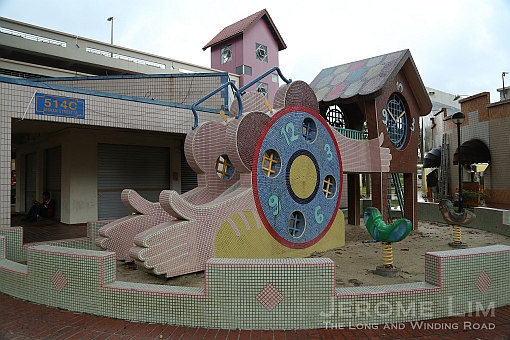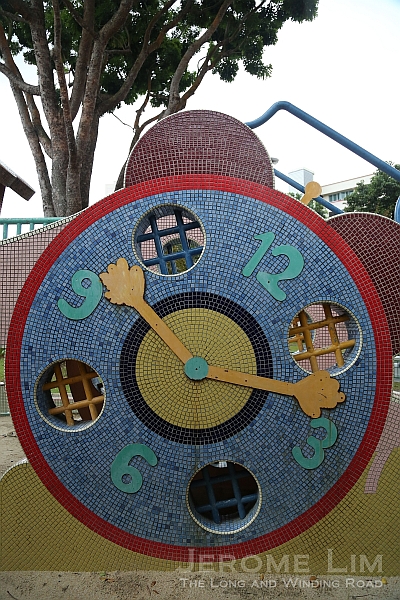A bumboat sits high and dry, resting on a bed of sand in Pasir Ris, seemingly out of place in a sea not of water, but one of the concrete structures which now dominate much of Singapore’s suburban landscape. The boat is itself made of concrete, built not to carry the loads that the wooden vessels it is modelled after over water, but to provide a place where children of the neighbourhood it finds itself in can find amusement.

The bumboat of Pasir Ris.
The boat, designed to resemble the bumboats or twakows – the workhorses of the once busy Singapore River, is one of several unique playground designs that hail from a time we seem to have forgotten. It was a time during which the Housing and Development Board (HDB) had a department within their Landscape Studios, dedicated to developing playground designs to complement the landscape of the public housing estates that were fast coming up, during which several notable playground designs were developed.

The starboard side.
The efforts go back to the mid-1970s, when Mr Khor Ean Ghee designed the original dragon (playground) of Toa Payoh. That stood in a pit of sand at Toa Payoh Town Garden. This design was to serve as a basis for the sand-pit mosaic-faced dragons, pelicans, doves, elephants and spiders which would have been a familiar sight to the child of the late 1970s, the 1980s and perhaps the 1990s, with a vast number built together with the huge second public housing building wave which started in the mid-1970s which was to see the monster estates such as Ang Mo Kio, Bedok and Clementi being built. Several of these playgrounds were also installed in the older estates, of which a few are left. One is the orange dragon of Block 28 Toa Payoh and another, the last dove standing at Dakota Crescent.

Climbing the dragon at Toa Payoh Town Garden, 1975.
Moving into Ang Mo Kio in the late 1970s, it was the pelican that I encountered not far from where I lived in Block 306. These playgrounds also marked a shift in playground layout. Whereas the ones I played on in the late 1960s and early 1970s, many with tubular steel structures on a hard concrete ground, were set expansively such that children playing seemed to have no boundaries, the new designs were a lot more compact sets of concrete with terrazzo and mosaic finishes placed in a a raised pit of sand, had well defined boundaries. Perhaps I had by the time outgrown playing at the playground, but having spent most of my childhood climbing on metal waves and globes, swinging from swings suspended by long lengths of chains, and sliding down high steel slides, the new playgrounds offered a lot less enjoyment to me.

The playground I derived the most pleasure from – the one in front of Block 53 Toa Payoh when I lived there (scan of a postcard courtesy of David Jess James – On a Little Street in Singapore).

The last pelican which has been demolished.
From the animals of the early 1980s, the designers explored fresher themes during a two year period from 1983 to 1985. These efforts yielded designs which revolved around well-known fables such as the tortoise and the hare and also familiar local objects such as kampung houses and trishaws. It was from the next creative wave from 1986 to 1990 that the bumboat was designed. One of 23 designs from the period, the bumboat was one of several which included a kelong designed to represent elements of our multi-racial heritage – the bumboat a representation of Chinese heritage (the twakows were wooden boats used by Chinese traders to carry goods from the ocean-going ships anchored in the inner harbour to warehouses up river).


The period also yielded other rather interesting designs which included those which revolved around nursery rhymes such as Humpty Dumpty and the Old Woman who lived in a Shoe; popular childhood games such as snakes and ladders; designs inspired by fruits and vegetables such as the watermelon, mangosteen, pineapple, mushroom and egg plant; and also insects such as ladybirds. A few of these can still be found including a watermelon and mangosteen in Tampines and a double clock in Bishan. Other interesting structures put up during the time included everyday objects, of which the clock is one example, a telephone, a lorry, and not so common (at the time) items such as a bullock cart.

The passing of time. A last clock stands in Bishan.
During the same period, attempts were also made to provide the newer estates being built with their own identity. Playground designs were also selected for new towns on the basis of this identity. An example of this is the use of fruits and vegetable themed playgrounds in Choa Chu Kang – developed from what was a rural and farming area of Singapore. While the selection of playgrounds were very much left to the architects responsible for the designs of each neighbourhood, an attempt was made to allow for some variety across each estate in which playgrounds were distributed such that there was one for every 400 to 800 dwelling units by limiting the use of any design to maximum of five per estate.

The more complete face – with the hands intact.
The death knell for many of the homegrown playground designs was probably sounded with the advent of modular play equipment in the 1990s. This, coupled with safety concerns raised by a Canadian playground safety expert which followed an incident in 1993 in which a five-year old boy had his thumb severed whilst sliding down a poorly maintained metal slide in an older playgrounds (fortunately his thumb could be reattached) saw a change in direction on the part of the HDB. While there was probably a conflict of interest on the part of the expert who also represented a Canadian modular play equipment manufacturer, the safety concerns could not be ignored.

The watermelon.
While some of the older playgrounds were upgraded to improve their safety including having sand pits which were thought to be too shallow replaced with rubber mats which provided a soft landing, a massive wave of upgrading efforts which swept through many of the older HDB estates in the 1990s and 2000s did see many of these playgrounds demolished in favour of modular equipment which were also a lot easier to maintain and the population of the distinctive mosaic faced structures dwindled over time to the handful we find today. Although there is hope that at least one, the dragon of Toa Payoh (see news report dated 19 May 2013) will be kept for some of us to remember a time which will soon be forgotten, there probably is not much time left for some of the others for children of the 1980s and 1990s to catch the boat to bring them back to their childhoods (a dove, one of two that did remain, was very recently demolished) before these structures along with much that is familiar is erased from our ever evolving suburban landscape.

The mangosteen.
Old playgrounds:
- The huge playground I practically grew up in (Block 53 Toa Payoh) [demolished]
- The iconic dragon of Toa Payoh
- Another look at the dragon
- The dove which was recently demolished
- The last dove at Dakota Crescent
- The Elephant of Pasir Ris
- One recreated by NParks for Five Decades of Greening in Singapore




































































